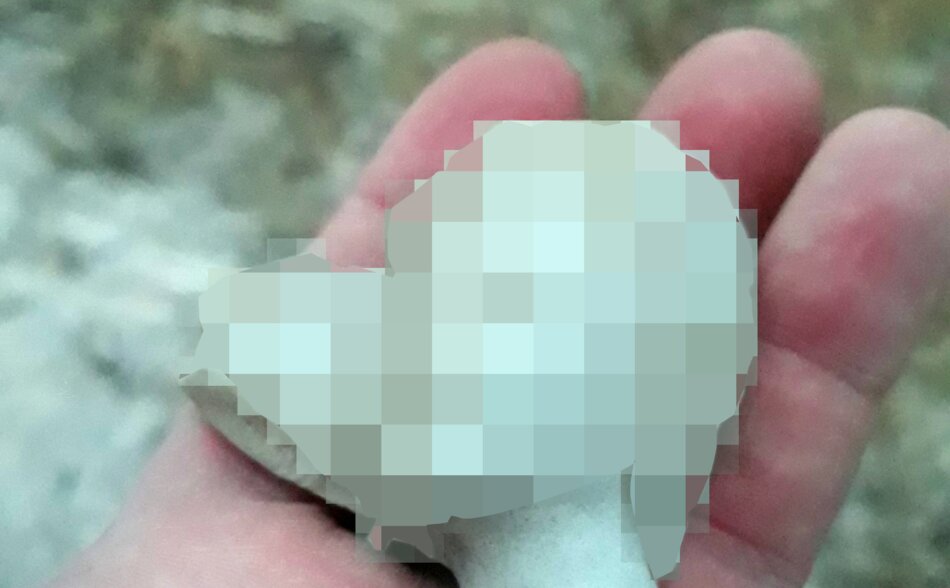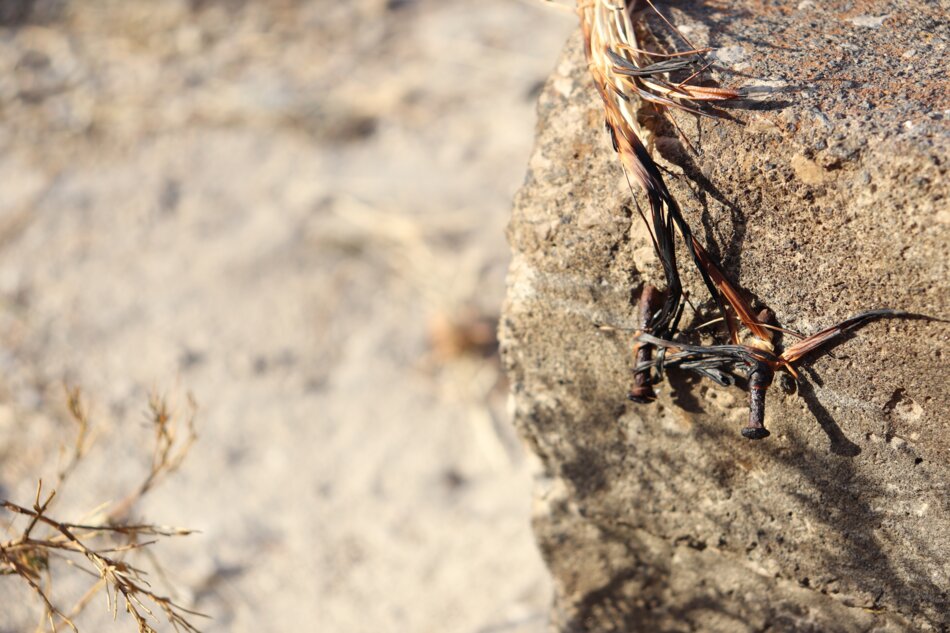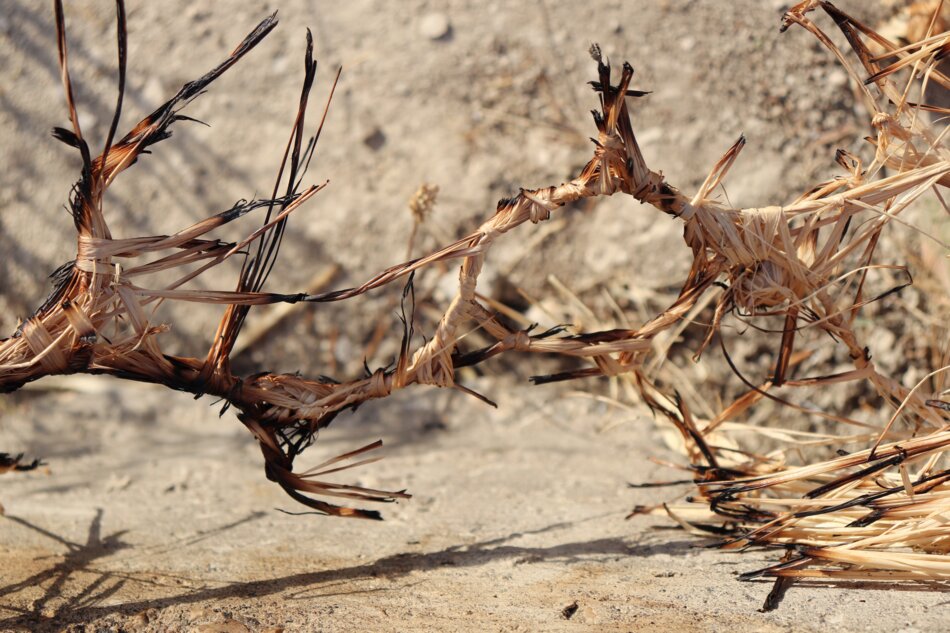Portfolio Entry
I found a broken sculpture with two human heads in a rural area. This sculpture inspired me to create a work about sharing a vision.
View Full-Size Image
“Slash-and-Burn Environment,”
contrada la Strada, Butera, Caltanissetta, Italy;
Terraformation art residency, curated by Mayer Pavillion, with the support of Farm Cultural Park;
photo by V.F. Marrese;
©VFMarrese.
Click to download HD Image (for press use only). Please credit V.F. Marrese. Contact us for other use or licensing.
Download via Alternative Link.
Artwork Details
Title:
Slash-and-Burn Environment
Year:
2024
Medium (Type of Art ):
environmental art
Unique Feature:
the artwork was almost entirely burned during a fire and later activated by a time-based action with Sandra Chrzanowski, Andries De Lange, Luïza Luz, and Andrea Mineo
Medium (Materials ):
concrete pillar block, natural found objects (animal skulls, animal vertebrae), natural raffia
Dimensions (International ):
68×77×31 centimeters
Dimensions (British and US ):
26.77×30.31×12.20 inches
Venue:
contrada la Strada, Butera, Caltanissetta, Italy
Setting:
Terraformation art residency, curated by Mayer Pavillion, with the support of Farm Cultural Park
Ethical Statement
Animal bones are respectfully included to raise awareness of our complex ecosystem. This work does not reference any cultural or religious practices;
Establishing Context
I found a broken sculpture with two human heads in a rural area. This sculpture inspired me to create a work about sharing a vision.
We were invited to an art residency to envision the artistic future of a vast rural area.
While collecting some wasted materials like plastic, metals, glass, from the rural area, I suddendly found a fragment of a sculpture.
View Full-Size Image
Found object, fragmented sculpture; faces of the sculpture have been pixelized to respect the unknown creator’s rights.
contrada la Strada, Butera, Caltanissetta, Italy;
Terraformation art residency, curated by Mayer Pavillion, with the support of Farm Cultural Park;
photo by V.F. Marrese;
©VFMarrese.
Click to download HD Image (for press use only). Please credit V.F. Marrese. Contact us for other use or licensing.
The fragmented sculpture depicted two interconnected human heads. The two connected human heads showed unity. Yet, broken into pieces, they reveal this challenge. It shows how hard it is for people to think together.
I kept the sculpture with me and walked through the rural field.
Then, I discovered a concrete pillar hidden in the vegetation. I stepped onto it. I turned to see the landscape all around. The view felt like a shared experience, inspiring me to create art and invite other artists to join me.
View Full-Size Image
Found object, weathered concrete block in a grassy field, blending with the natural surroundings.
contrada la Strada, Butera, Caltanissetta, Italy;
Terraformation art residency, curated by Mayer Pavillion, with the support of Farm Cultural Park;
photo by V.F. Marrese;
©VFMarrese.
I covered the pillar with raffia to create a network of threads.
View Full-Size Image
Found object, a weathered concrete block in a grassy field, intricately covered by a network of raffia threads;
contrada la Strada, Butera, Caltanissetta, Italy;
Terraformation art residency, curated by Mayer Pavillion, with the support of Farm Cultural Park;
photo by V.F. Marrese;
©VFMarrese.
While walking in the rural area, I discovered animal bones. I began assembling them with raffia, contemplating the concept of unity.
View Full-Size Image
While walking in the rural area, I discovered animal bones. I began assembling them with raffia, contemplating the concept of unity;
contrada la Strada, Butera, Caltanissetta, Italy;
Terraformation art residency, curated by Mayer Pavillion, with the support of Farm Cultural Park;
photo by V.F. Marrese;
©VFMarrese.
I unexpectedly found two nails on one side of the pillar, which I used to enhance the network of threads. With my “subtle habitat” idea, I enjoy uncovering hidden details in the environment to aid in creating the artwork.
View Full-Size Image
I found two nails on a pillar and used them to enhance the thread network, embracing the “subtle habitat” concept;
contrada la Strada, Butera, Caltanissetta, Italy;
Terraformation art residency, curated by Mayer Pavillion, with the support of Farm Cultural Park;
photo by V.F. Marrese;
©VFMarrese.
Click to download HD Image (for press use only). Please credit V.F. Marrese. Contact us for other use or licensing.
I spent several days creating the raffia net. I often visited the pillar early in the morning to avoid the intense daytime heat. Around six in the morning, a couple of lizards would typically appear from a rock I named “lizards’ rock.” By seven o’clock, ants would arrive, becoming the first visitors to my work. They traversed the raffia strings with curiosity, using them like highways.
View Full-Size Image
Early in the morning, ants arrived at the pillar, becoming the first visitors to my raffia net. They curiously traversed the strings, using them like highways;
contrada la Strada, Butera, Caltanissetta, Italy;
Terraformation art residency, curated by Mayer Pavillion, with the support of Farm Cultural Park;
photo by V.F. Marrese;
©VFMarrese.
Click to download HD Image (for press use only). Please credit V.F. Marrese. Contact us for other use or licensing.
View Full-Size Image
By seven o’clock, the ants began their journey across the raffia net I meticulously created. They moved with curiosity, treating the strings as their own intricate pathways;
contrada la Strada, Butera, Caltanissetta, Italy;
Terraformation art residency, curated by Mayer Pavillion, with the support of Farm Cultural Park;
photo by V.F. Marrese;
©VFMarrese.
Click to download HD Image (for press use only). Please credit V.F. Marrese. Contact us for other use or licensing.
In this peaceful rural area, I started to feel a connection with its inhabitants: reptiles, insects, and the dry plant landscape.
As the work neared completion, visitors arrived, and I hosted an open studio event outdoors, narrating the story of the work by an artistic action.
View Full-Size Image
As the work neared completion, visitors arrived, and I hosted an open studio event outdoors, narrating the story of the work through an artistic action;
contrada la Strada, Butera, Caltanissetta, Italy;
Terraformation art residency, curated by Mayer Pavillion, with the support of Farm Cultural Park;
photo by Andries De Lange & Luïza Luz;
©Andries De Lange & Luïza Luz.
A few days later, the area caught fire, and the raffia net almost burned completely.
View Full-Size Image
A few days later, a fire broke out in the area, nearly destroying the raffia net;
contrada la Strada, Butera, Caltanissetta, Italy;
Terraformation art residency, curated by Mayer Pavillion, with the support of Farm Cultural Park;
photo by V.F. Marrese;
©VFMarrese.
Click to download HD Image (for press use only). Please credit V.F. Marrese. Contact us for other use or licensing.
A local person informed me that fires in the area were common, sometimes deliberately set to encourage faster growth of new vegetation. An artist mentioned similar practices in their own country. Intrigued, I delved deeper and began researching this practice known as slash-and-burn.
View Full-Size Image
Wheat bales in a field ravaged by slash-and-burn. My raffia artwork was almost destroyed in the recent fire;
contrada la Strada, Butera, Caltanissetta, Italy;
Terraformation art residency, curated by Mayer Pavillion, with the support of Farm Cultural Park;
photo by V.F. Marrese;
©VFMarrese.
View Full-Size Image
A lone tree in a burnt field. My raffia artwork, nearly consumed by the flames, reflects the instability of rules;
contrada la Strada, Butera, Caltanissetta, Italy;
Terraformation art residency, curated by Mayer Pavillion, with the support of Farm Cultural Park;
photo by V.F. Marrese;
©VFMarrese.
View Full-Size Image
A Sicilian hillside burned by controlled fires. The site where my art project faced near ruin;
contrada la Strada, Butera, Caltanissetta, Italy;
Terraformation art residency, curated by Mayer Pavillion, with the support of Farm Cultural Park;
photo by V.F. Marrese;
©VFMarrese.
After the flames died down, I went to the area. It smelled strongly of smoke, and I could still feel the warmth from the fire.
View Full-Size Image
“Slash-and-Burn Environment,”
contrada la Strada, Butera, Caltanissetta, Italy;
Terraformation art residency, curated by Mayer Pavillion, with the support of Farm Cultural Park;
photo by V.F. Marrese;
©VFMarrese.
Click to download HD Image (for press use only). Please credit V.F. Marrese. Contact us for other use or licensing.
The fire nearly destroyed my artwork. It left behind fragments. These fragments only showed part of the network of threads, which suggests that the rules aren’t as stable as we thought.
View Full-Size Image
“Slash-and-Burn Environment,”
contrada la Strada, Butera, Caltanissetta, Italy;
Terraformation art residency, curated by Mayer Pavillion, with the support of Farm Cultural Park;
photo by V.F. Marrese;
©VFMarrese.
Click to download HD Image (for press use only). Please credit V.F. Marrese. Contact us for other use or licensing.
View Full-Size Image
“Slash-and-Burn Environment,”
contrada la Strada, Butera, Caltanissetta, Italy;
Terraformation art residency, curated by Mayer Pavillion, with the support of Farm Cultural Park;
photo by V.F. Marrese;
©VFMarrese.
Click to download HD Image (for press use only). Please credit V.F. Marrese. Contact us for other use or licensing.
A few days later, I invited the other artists in residence to join me in activating the artwork through a collective artistic action. Each artist held the sculpture I had found, stepped onto the concrete pillar, and observed the surroundings as I had initially. Together, we silently considered a shared vision, passing the sculpture to the next person as they descended from the pillar. The last artist returned the sculpture to me.















